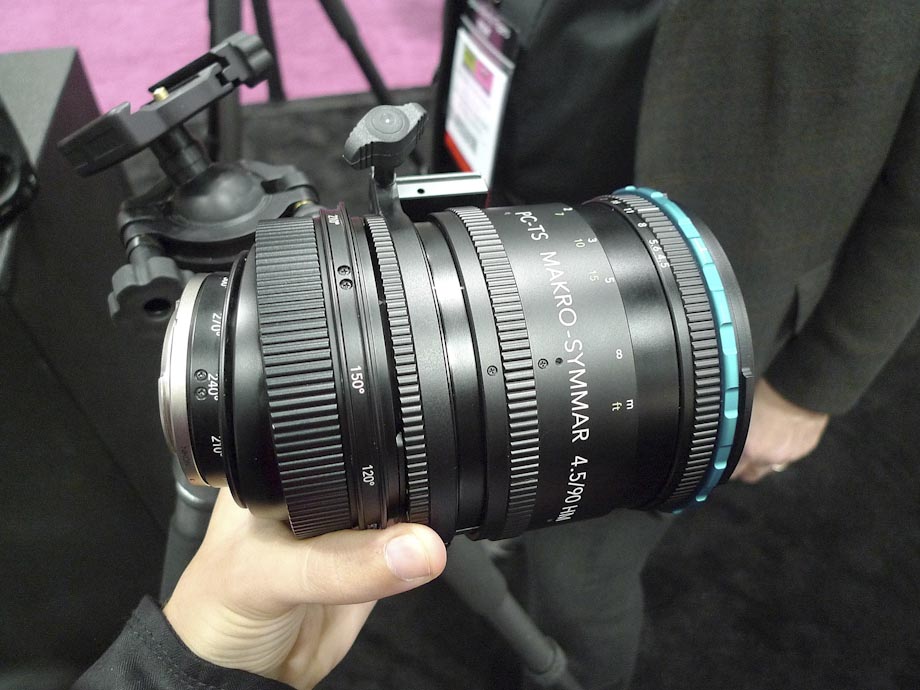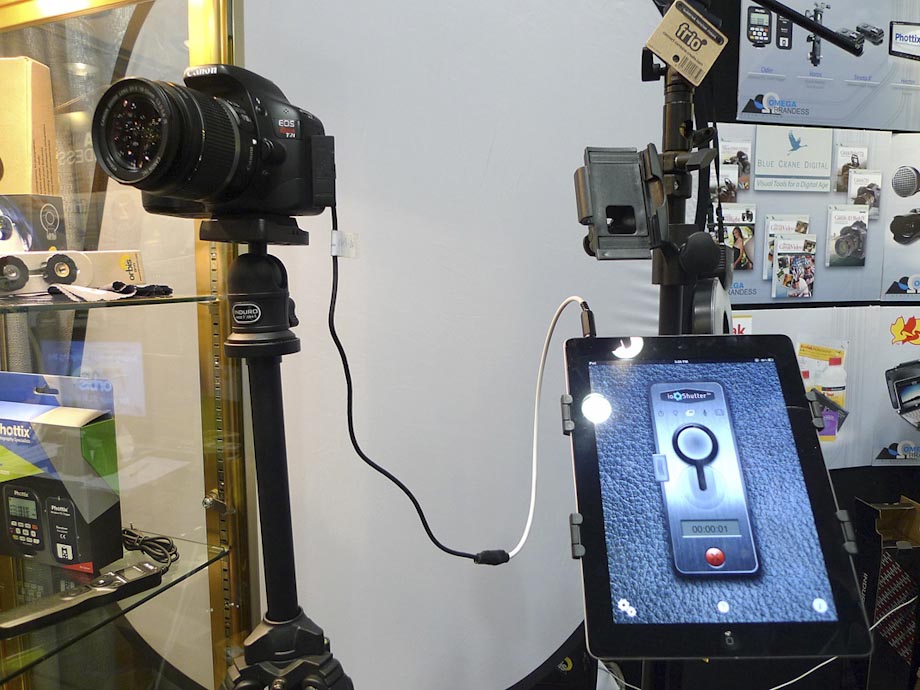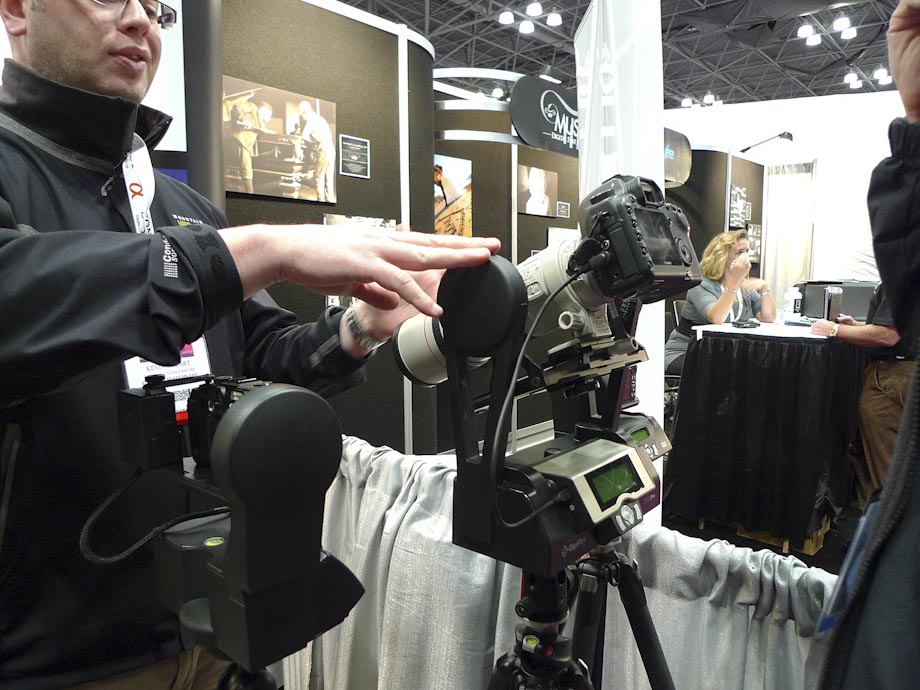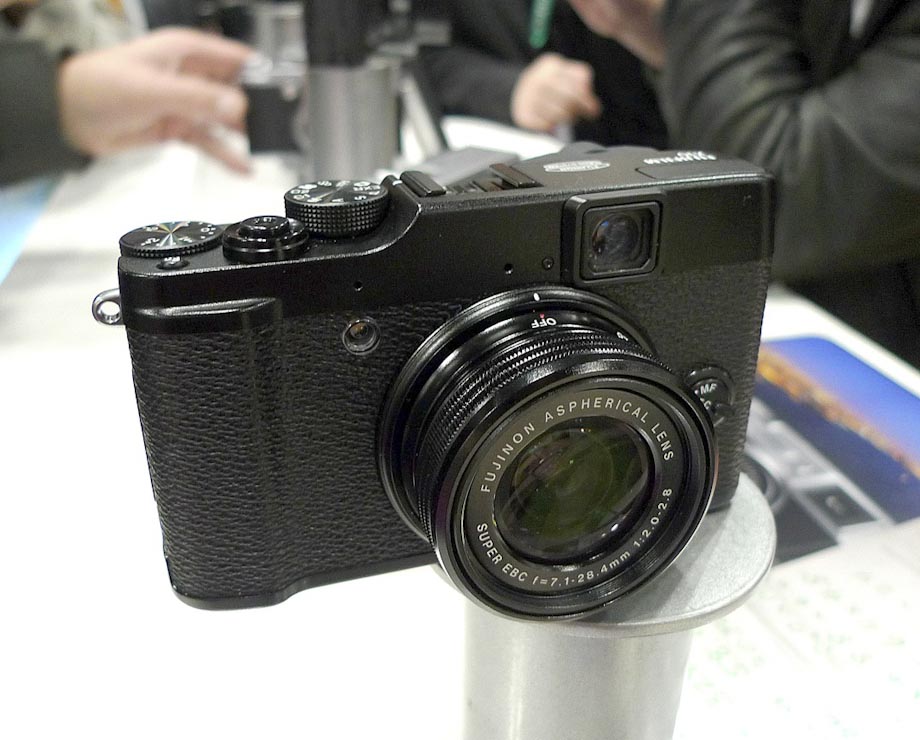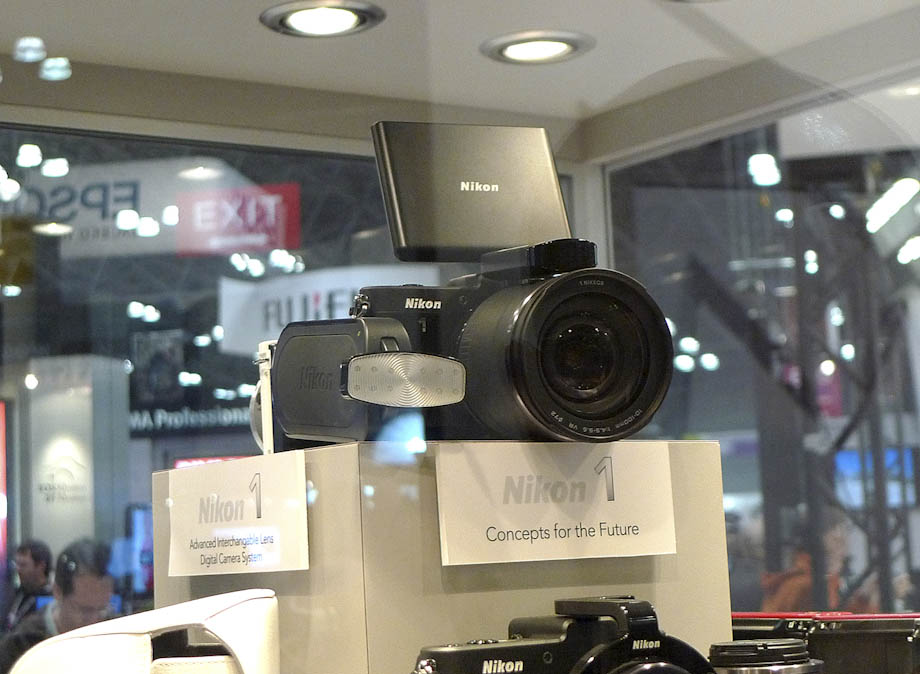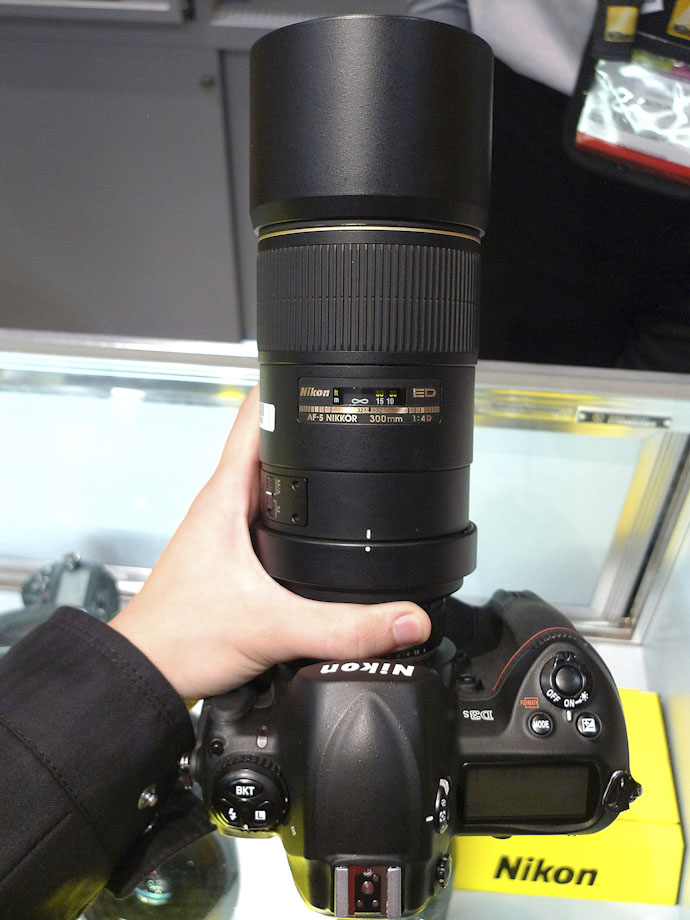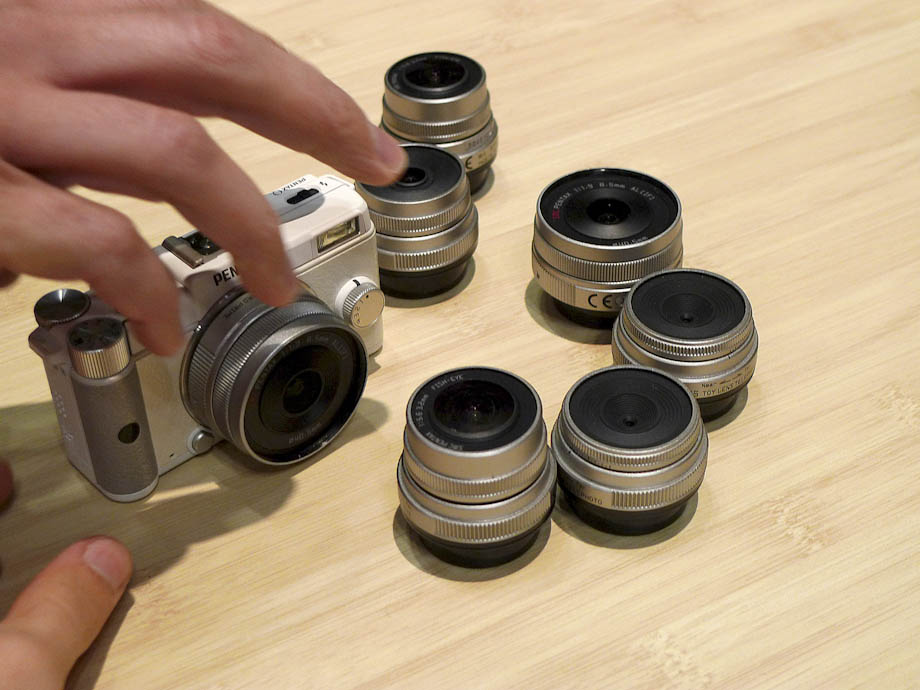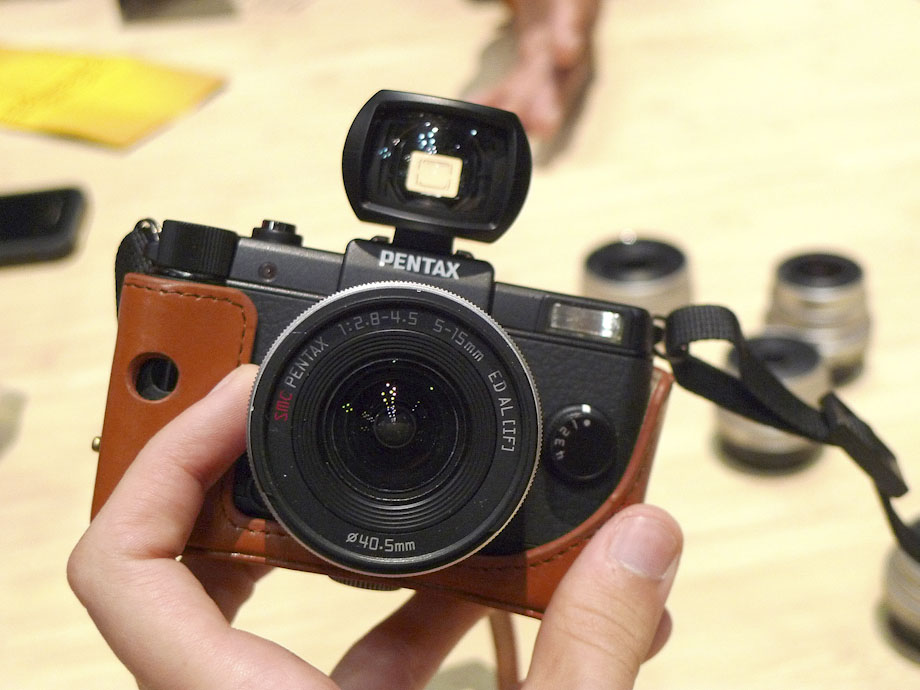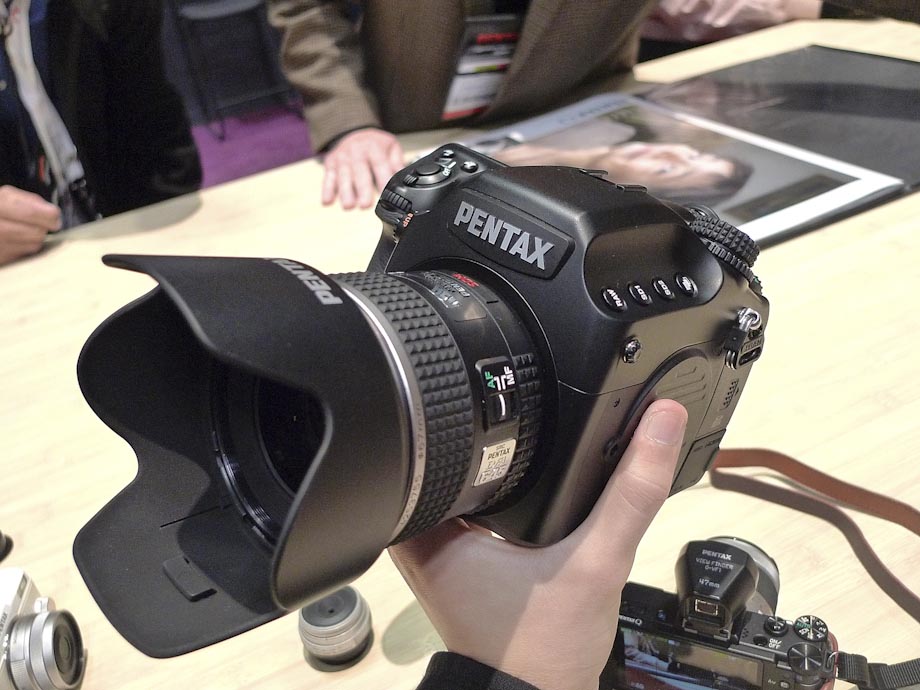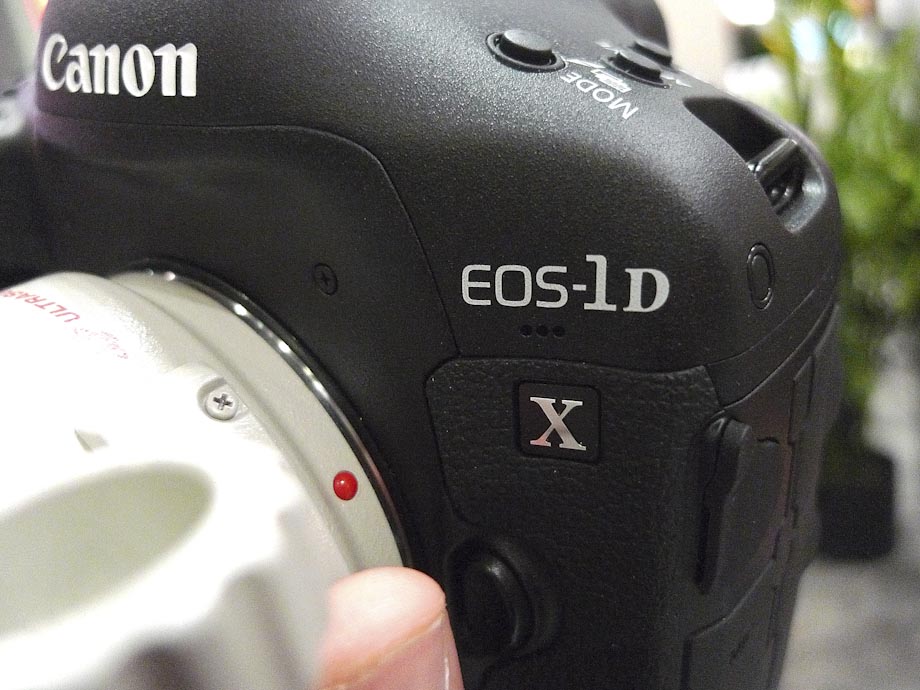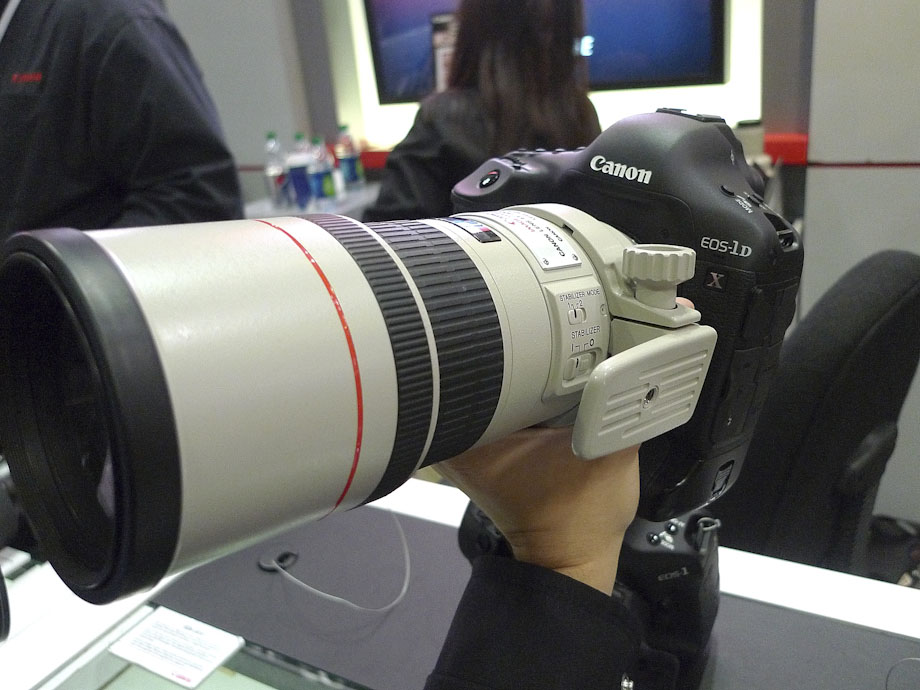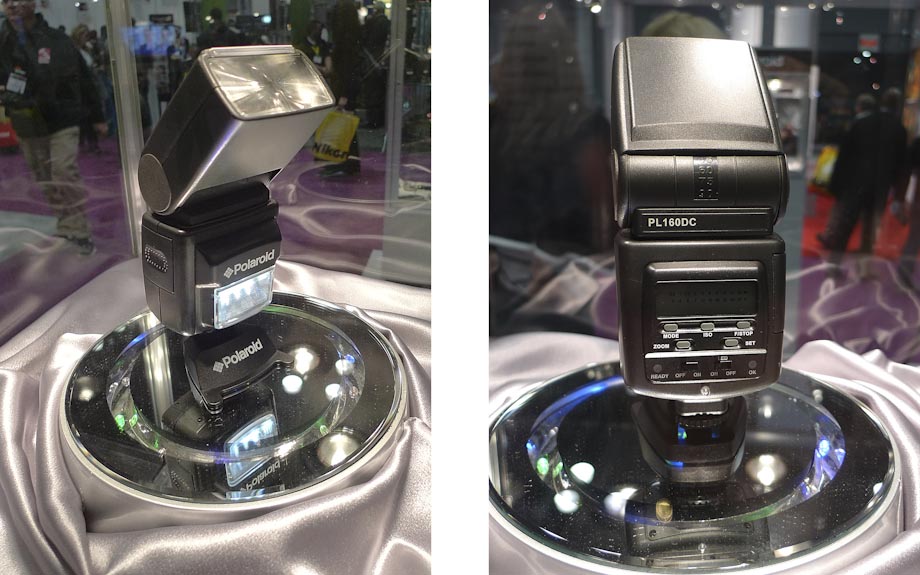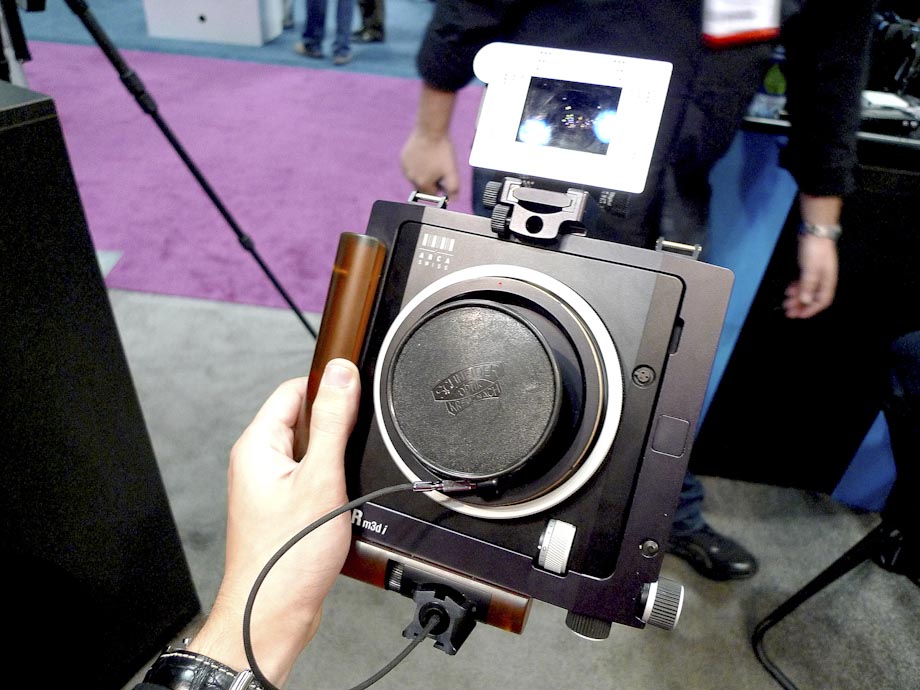This is a guest post from Brian Hirschfeld (brianhirschfeldphotography.com) on the PDN PhotoPlus show that took place in New York last week (check also my report on NikonRumors):

Left: Inside the Javits Center. Right: A poor representation of the scene outside the Javits center since the image fails to capture the blizzard of snow and ice whipping by every second with the wind.
Saturday October 29, 2011 was a day to remember. Leaving my house in Connecticut at around 11:30 with flurries falling I wasn’t to concerned about the weather; I was going to PDN Photoplus after all. Around Greenwich when the snow intensified I continued on but started to question my resolve. Nonetheless I made it into the city and to the Javits Center.
Usually when I attend these sort of shows, I take with me some significant camera either my D3s or my M9 because I like to have a nice camera for me for the rest of my time wherever I am. Of course they don’t hurt your credibility when asking to see expensive gear. This year however I only took my D-Lux 4 point and shoot tucked away in my pocket. As a whole I was pleased with the way I was treated and glad to confirm my suspicions that it wouldn’t affect my credibility if I was clearly knowledgeable about different products.
I didn’t address Leica in this review because, as always they are amazing, they let you play with everything, and love talking about it. And of course again much to my torment, they have all of their glass their, all of that rare glass that is impossible to get new from a dealer. They had M9P’s which look great. I will have mine converted when the demand or the conversion is lower and the back order isn’t at January for the conversion. It looks good and adds to the camera’s aesthetic and functionality by making it that much more subtle. The only new thing with the S system was the 30mm Lens which no one really cared about anyway. They need more lenses there is no denying that, and I harp on that many times in the reviews below. But they are a great company with great service and that’s undeniable, even more importantly they make the best optics in the world (if you ask me, which you did since you are reading this). There are pictures of some lenses and the M9P and S2 on my Flickr page.
I should add that these are as much my opinions as well as coverage of the show since I really only talks about things that I found interesting and because I’m a narcissist how they relate to me. This should be noted before giving me too much grief in the comments section although I welcome corrections and criticism in a friendly and proper manor 😉
For more pictures see http://www.flickr.com/brianhirschfeldphotography.
Cool things that you might have missed – Schneider-Kreuznach PC TS Super Angulon’s
It would’ve been very easy to walk by the Schneider booth at PDN Photoplus simply because its kind of intimidating. Its German, and its not Leica. They make great optics, most of which you’ll never use because they are large format. And they are pretty damn expensive since they are pretty damn good. Not to mention there are D3’s, 1D’s and Leaf Backs being shown with GIANT TILT SHIFT LENSES on them. Since most people (myself included to a slight extent, although I’m getting better) don’t entirely grasp the concept of tilt shift lenses. All of this leads to a pretty quite, although quite large booth.
First off, these lenses are amazing, they really are. They are built so well they almost defy explanation. They can’t be compared to Leica’s because they are not. They are Schneider’s. Leica’s lenses are very simply; straightforward and streamlined like the brand. This lens is big, bulky and high in functionality and all metal. It has so many moving parts it defies description and I won’t even endeavor to explain all of them. It’s a fully manual lens, no communication with the camera, you set your aperture and everything on the lens and set your exposure on camera and bam there you go. It’s a perspective control, tilt shift lens on steroids. Its mostly similar to Nikon and Canon’s tilt shift lenses in that they tilt and shit. Schneider’s is inherently bettered designed because of the optics house it hails from. This goes without saying. What doesn’t go without saying are the different an amazing ways this camera interacts with cameras. Most interestingly to me is the mount to the camera. It is possibly by turning a nob at the back to have 360 degree rotation of the camera, but not the lens. The lens will stay in a fixed position but the camera can be repositioned. This is an amazing feature for stitching. Although I don’t remember the dimensions exactly, its possible to take an image, flip the camera mount upside down, so the camera is upside down, take another exposure, merge them together and have it was either a 6x17or a 6x24 image. I thought this was great. Combined with many other perspective modifying features of this lens its really amazing for architecture and landscape work. While less relevant to me in the Nikon and Canon mounts because these are quite small and don’t benefit a huge amount from lens/camera movements, I was more interested in the PhaseOne mount version which has all of the same features of the Nikon Canon models which apparently also have interchangeable mounts according to the sprite and chipper German Schneider rep who clearly knew what he was talking about. I was really pleased with this lens as well as the service delivered by the Schneider rep by his in-depth knowledge and eagerness to talk about the product to someone. I will definitely try and find an excuse to buy this lens.
ioShutter
Despite appearances, ioShutter had a rather prime location at the end of an isle and right next to borrow lenses; this product may have been overlooked by some. It is a fairly simple idea that you would’ve expected to come about by now. The App is currently available for download in the app store but it won’t really do you much good without the cable which will be available in December according to their website. Also I THINK NOT SURE it might just be for Canon at the moment and will be available for Nikon and I think Hasselblad was mentioned and PhaseOne in the pipeline. Anyway it’s a shutter release cable driven by your iOS device. It has time functions as well as interval release functions useful for time-lapse photograph. While I don’t know if only as a shutter it is that useful since how much room does a cable release really take up anyway? But with the added time-lapse and easy locking features combined with the fact that almost every person on the planet has an iOS device, and the ones that don’t are currently in-line to get one, and so many people have DSLR’s and pro-sumer models that might benefit from this feature, I really hope this concept succeeds.
Gigapan Systems GigaPan Epic small update
First of all, my first victory in my crusade for the underrated 300mm f/4 lenses! There’s one mounted on a canon on a Gigapan Epic. Second since my primary interest is in medium format photography, anytime I see anything cool and techno-gadgetry as relates to camera’s I ask, does it work with PhaseOne 645DF? What about a Hasselblad H? So often the answer is no, but here the answer was YES! Kind of. Works with Hasselblad which is great, except I’m trading that in for a PhaseOne. The rep pictured left, explained that they are currently working with PhaseOne to get the cable right to communicate properly between the Gigapan Epic and the Phase 645DF body, just an interesting note, no real thoughts on it one way or another.
Fuji
Fuji has come a long way in the last year, and I am very impressed with them. They released the X100 and its ridden a wave of hype to almost being widely available a year later. It’s a great little camera, really vintage looking, and kinda sorta opening up peoples mind to the arcane but magical world of rangefinders once again. After holding the X10 and being able to directly compare it to the X100, I have to say I walked a way with a very favorable impression of the X10. That is not to say the X100 isn’t a pretty cool camera but it isn’t that valuable of a tool to me as an M9 shooter. It is a very fun camera and certainly has some novelty value masking its true potential as a camera. But anyway back to the X10 I thought it took everything that was good about the X100 and added in some useful point and shoot features like, smaller size and zoom lenses. Again being an M shooter as well as a fan of prime lenses the X100’s lack of a zoom lens was by no means a deterrent from it in my mind. All that said about Prime lenses, the lens most often on my D3s is my 24-70mm 2.8 because it is the most convenient for general and most travel photography for me. The X10 adds a nice little zoom lens into the equation and it preforms admirably. The X100 had a pretty fast autofocus speed and the X10 seemed to be faster to me. In terms of functionality the X10 seemed on par if not better then the X100. The X10 however, excelled in the size war. I felt that it really did take the good things about the X100 and put them in a smaller, more point and shoot, sized body. It clearly can compete with the big pro-sumer model’s from Canon and Nikon The G12 and P7000 respectively. It does beat them if you ask me, it looks better, it is faster, it has better controls and its manual zoom lens is nicer if you ask me. It gets you more involved in the photography. While you loose the fun and total involvement of an aperture ring it does get both of your hands on the camera and gets you more into being a photographer which I like and think will do wonders for those who use it and photography as a whole if more cameras follow this trend of reverting to the basics (so well exemplified in the M series) and bringing thought and understanding back into mass photography. Again, that said it’s a double edged sword you get all these really cool, back to basic features, but you still wind up paying a premium, not Leica insane but its still kinda like buying a Porsche GT3 where you pay more to have them take stuff out of the car.
A note about the upcoming Fuji interchangeable lens camera system. I after fondling the X100 and X10 in silence and not acknowledging the presence of their rep since there really wasn’t any need to talk to him, surreptitiously snuck in an out of no where question, catching him completely off guard, which I hoped would lead to him slipping up and revealing something. “So when will this new interchangeable model with an M mount be announced?” rep “Uh Hi, well it will be out in the spring [I already knew that part] and I should add no one said anything about it being an M-mount system.”. And this guy was really no fun at all so I didn’t bother mentioning about the m-mount patent being up and all that stuff. At the same time I would and wouldn’t be surprised if this new system was a modified m mount to allow for autofocus and a like while accepting all Legacy M lenses. But that’s not a prediction, that’s a hope.
Nikon
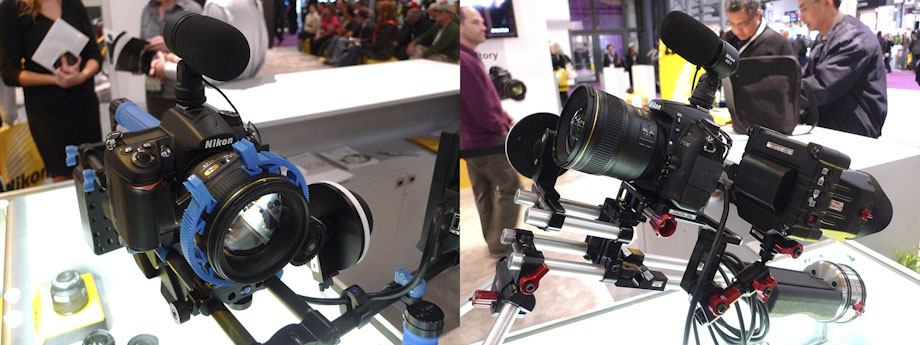
Left: Red Rock Mirco with an appropriately blue styled DSLR rig with large LCD finder and Nikon’s Microphone Right: Zacuto HDSLR rig with their new-ish electronic viewfinder solution which I thought was really great. It can be used with or without the hood and give a really nice BIG electronic viewfinder for precise focus control with the attached follow focus.
Oh Nikon you wonderful behemoth the things you give us are so great. You even Dane to support other brands that compliment your system, how wonderful! I was really intrigued to see that Nikon had a Zacuto and Red Rock Micro DSLR video kit available to be fondled to advertise not only their cameras and lenses but the viability of their cameras as a HDSLR solution. I had never held one of these contraptions before and as the eager sales rep pointed out “they take a little while to get used to” but once you have figured it out they become fairly natural and easy to use. Both setups are pictured with a Nikon D7000, 85mm 1.4G and Nikon Microphone attached.
Nikon had a really great display of a lot of their future concepts for the mirrorless system including of course lenses as well as some very nice viewfinders and LED lighting setups for photography and video; not to mention a almost tasteful myriad of color options that totally blew Pentax’s mind since some of theme even seemed tasteful. Pictures of these can be seen with many others on my flickr page.
I thought the Camcorder design pictured above was one of the best. It adds a side handle, which has a built in continuous light source for easy video recording. It also featured a hot shoe mounted large viewing screen for control over the various options while recording video. Not to mention it does this all off of one body and with interchangeable lenses. I wouldn’t ever really consider it since it isn’t my thing but I can really see this catching on if they can implement enough different accessories that it lens itself to creativity as well as convenience for the less creative consumer segment.
Also its really great that they feature all of these different lenses as future concepts and describe who they will be useful for on the description cards for each but they decidedly aren’t working prototypes since they aren’t touchable or even if they are working no one would know it since you cant touch them. I understand Nikon is having a tough time at the moment but wouldn’t have been better to wait and have a fully developed lenses line when the camera launched? For the moment Canon is still without a mirror less system and there haven’t been any leaks of a Canon mirror less prototype, which suggests they, are either holding the designer’s and production staff’s families hostage or it doesn’t exist. Nikon probably could’ve waited, designed, and produced a few more lenses and released them with it, but then again that’s kind of like back seat driving since I’m sitting on my bed and not in the Nikon boardroom. But seriously if Pentax could do it, couldn’t Nikon? (and I know the Pentax lenses feel like you got them out of one of those gumball machines with the prizes but still you get the point.
Continuing my purely scientific interest in Nikon and Canon’s 300mm f/4 telephoto lens offers, and confirming that no one has every actually used one by talking to multiple Nikon reps, I investigated the Nikon Offering. It is certainly better built then the Canon equivalent in terms of weather sealing and overall build. It’s a true Nikon lens through and through. That said I liked the way the Canon version felt more, honestly. They both autofocused about the same speed (very unscientific test) with a slight favor towards the Nikon in this respect. They both seem to be really nice compact lenses and I don’t know if people buy them but are ashamed of it or if they haven’t been deemed to be worth anyone’s time to review? But I’ve decided to make it my personal crusade to do these lenses justice!
Pentax
After being acquired by Ricoh I was curious to see what Pentax would bring to the table. See that was funny to me since all Pentax really had were to tables, albeit very nice open wooden ones with a nice aesthetic. I was expecting a heavier focus on the Ricoh product line, but there was only one camera present. One that frankly I was a bit remiss in not investigating further, the A12 M mount cartridge for the Ricoh GXR. The rest of the combined Ricoh/Pentax space other then the limited corner of the table the Ricoh GXR M mount was on (it had its own sales rep though) was taken up with Pentax Products. Essentially one of the whole tables was devoted to the new and amazing Pentax Q the cutest damn little camera I’ve ever see. From what I’ve seen its images haven’t been that impressive, but look at it! Its so Tiny and cute and you can fit all the lenses (including the zoom), and optical viewfinder in a small-medium sized pocket! And don’t even get me started on that cute little faux leather case, it just makes it look so quant and old fashioned!
All joking aside though, it is tiny. I mean tiny. I mean I’m pretty sure a PhaseOne battery weighs more. And better yet (all other manufacturers should note this) IT WAS ANNOUNCED WITH A FULL RANGE OF LENSES granted collectively I’m pretty sure they use as much glass as a 20 fl oz plastic coke bottle but they are all there, in the flesh, and touchable. They aren’t carefully protected from the public behind glass like the Nikon V1 / J1 concept lenses, or promised like Leica S lenses, they exist. They are there, and they are damn cute. The Jury is still out on this camera, I don’t expect it to be that great image quality wise, but hey its tiny, its complete, and its got all the buttons, who am I to badmouth it. Did I mention its absolutely adorable?
Pentax 645D – I’ve always had a bit of interest in this camera. It’s the closest I can come to saying that a reasonably priced new medium format system exists. Of course like the S system from Leica, it is a closed system, the back cannot be removed. But especially for Pentax this is less of an issue since they have all of the legacy 645 lenses a large number of which have autofocus. It can also use Pentax 67 lenses with an adapter that expands the lens range even wider. It seems like a nice entry point considering its cool 40mp and weather sealed body for more then half the price of a Leica S2 (don’t give me crap I’m being a jerk, of course the S is superiorly designed, built, and has better although limited optics.)
At Photoplus, the camera wasn’t on display. I asked the sales rep who had shown me the Q about this and he said that it was because the 645D rep had left the day before, awkward. Anyway the Pentax sales rep did give me an interesting line which I thought may be obvious but anyway….He said that Pentax is treating the 645D as a response to Pentax users who want a step up from the K-7. This make sense although I did want to point out that there is a major gap in their pricing structure between the price of a K-7 and the 645D. But I guess if you can afford a D3x category camera you can afford a ~10k medium format system alternatively. I think the 645D does a lot of what the S2 doesn’t that is to say, be affordable. It really does a good job of this. It has all the buttons of, controls, and functionality you want in medium format, it has nice (not superior) build quality, a developed system of lenses and some cool features like the tripod mount hidden by my thumb in the below picture. Pleasing entry-level system (although this has an awful awful stigma [stigma not sigma, sigma does have a stigma attached to it] it shouldn’t) or an amazing go anywhere backup to a large mp sized medium format system. Honestly, I think the S should be more in the 15k range and that would convert more people to Leica and competitively compete with a system like this.
Canon
Frankly in stark contrast to the jumpy and excited Nikon floor staff the Canon staff were all seated in chairs and look unenthusiastic. This doesn’t lend itself to inspire you to engage these people. But being the brave soul that I am I dared to disturb them and once you broke the ice they were more then happy to talk with you about any aspect of the camera and eager to let you put different lenses on it. OMG OMG it’s the Canon 1Dx have you seen those videos of the 12 FPS!!! CRAZY!!! And the 14 FPS in mirror lock-up WOWZERS. Pretty cool stuff but its hard to get to excited about it. It’s pretty amazing to operate the camera in motor drive at 12 fps but not life changing. I liked the 1984 F-1 Canon High Speed Motor Drive which had 14 fps a long time ago.
Anyway the most important development I noted was in talking with a Canon rep. That is, that the limit on video length has been raised and will not be limited like on the IDs Mrk IV. This is important since more and more these cameras are being used on film sets. One thing I made a point of looking at at the show were the Canon 300mm f/4L and Nikon 300mm f/4 because I had never had any experience with them or read anything coherent about them. I found the Canon version to be nicer actually, pretty nice and an interesting, compact fairly fast telephoto lens. Overall this was really all that Canon had to offer, frankly the show as a whole didn’t present that many new products, but it did showcase some of the latest and greatest which have been announced over the past few months. A little disappointing but I’m not one to complain.
A Brief Visit to Polaroid
Frankly one of the stranger booths in the room was Polaroid’s. It kinda sorta seemed like they pulled some stuff from storage, threw in some of their new products and put some poor sales reps in for good measure. They had some strange things there, like legacy polaroid land cameras and other peculiar eclectic treasures. They also had some I assume new to them reflex-mirror lenses which I don’t understand since these are typically now a days made by second-rate manufacturers and I think that these may mean that Polaroid has gone off the deep end. They had there new little pocket printer thing in a case with some sample images printed from it which weren’t very impressive. I don’t really see the point to this item, I guess its supposed to make it like a polaroid addition to digital since it prints it on the scene? I don’t know or really care.
The most interestingly strange part of the already peculiar Polaroid booth was the new camera flashes and LED hybrid. I guess its cool and a good concept. Why carry around an LED continuous light for when your doing video and a strobe with your HDSLR. It works as a concept. But I question whether anyone can feasibly put all this into a cohesive package that works, especially Polaroid. But who knows brands like quantum exist so go figure. Maybe Polaroid will be the next great camera peripheral maker, who knows, with Lady Gaga on the team (she still is right?) the sky is the limit and nothing can go wrong.
Digital Transitions ~ PhaseOne and Arca Swiss
Tucked away in the far corner of the convention area was the Digital Transitions booth. They are PhaseOne, Arca Swiss, and Schneider dealers among others. After finishing up a deal to trade in my H3Dii-39ms for a IQ180 I explored some of the other wares they had there. They had the other IQ series backs there (IQ140 and IQ160) and they preformed just as nicely as the IQ180, no complaints about any of them.
PhaseOne 645DF and V-Grip Air - Of course they had the PhaseOne 645DF and V-Grip Air which are a wonderful combination that I think is one of the most comfortable out there for medium format.
Lenses - They also had some of the newer PhaseOne (some Mamiya and some Schneider lenses). The Schneider LS lenses are beautifully made and are definitely a step above the focal plane shutter Mamiya rebranded lenses. Now, don’t get me wrong a good sample of a Mamiya or PhaseOne 645 lens preforms very nicely, I don’t mean to cast them in a bad light by saying that they are Mamiya lenses rebranded. The Schneider lenses other then being built like tanks are of course optically better. This is a fact that may be overlooked when seeing their headings as “Leaf Shutter” lenses.
1. PhaseOne 120mm AF Macro
Another highlight of the PhaseOne lens lineup present was the new 120mm AF Macro. I am sure there are some macro diehards and persnickety people who will suggest you don’t need autofocus on a macro lens. To which I will present the following. I own a Nikon 105mm f/2.8G macro; I don’t do that much macro photography. Since it is not my main area of interest I don’t use for its intended purpose that often, and when I do it is more as a novelty. But rather it is a close focusing short telephoto portrait lens (its also weather sealed and the 105mm f/2 DC is not). And this IS something that needs autofocus for convenience. This is where the 120mm AF Macro will really shine. As a fashion and portrait lens allowing the photographer different working distances with the subject. Also like the new Schneider 110mm and 150mm LS lenses, the 120mm AF Macro has a really nice new non-fluted bayonet hood. It is made of metal I believe and very solid and capable of protecting the lens. This is a feature I have disliked on many of the Mamiya designed lenses, their lens hoods are too plasticky. The 120mm AF Macro will definitely be a lens that I will be adding to my lineup in the near future.
2. Schneider 110mm f/2.8 LS lens
Unfortunately as my time with Hasselblad winds down, I have come to appreciate one of its lenses in a new light. The 100mm f/2.2 has become one of my favorite lenses recently preforming admirably wide open and stopped down. Aside from its optical performance, I have found, the focal length (which is exactly 78mm in 35mm format but effectively 85mm) is my favorite focal length. I don’t leave for any shoot without either my 85mm 1.4D or 85mm 1.4G, more recently the 85mm 1.4G because of its G series weather sealing. Anyway I digress. The 100mm f/2.2 has been great and yielded some of my favorite images of all time in the past few months. The Schneider 110mm f/2.8 while lacking the widest aperture of the Hasselblad 100mm f/2 retains the focal length that I enjoy and will also be coming home with me in the near future if I have my way. It is a superiorly built lens and a real stunner optically.
Arca Swiss RM3Di – While not my main area of expertise by any means and I know there are certainly others better versed in this field, I was interested in this technical camera. It is a competitor to the Alpa series of cameras and is also in a category of non-bellows technical cameras. I like the way Micheal Reichman called it this subset of technical cameras “The Worlds Most Expensive Point and Shoot” specifically referring to a Cambo in this case. Again, anyway I digress. Having handled Alpa’s in the past (actually at PDN Photoplus 2010), I would say the Alpa’s have an edge on build quality. However I have heard from a dealer that they are rather slow in sending out simple part requests for replacements and orders. Apparently Arca Swiss is better and this should be a noted consideration. Also because of its modular nature, I understand that a lot of other Arca accessories can be used in Tandem with it. System development should be noted and is important when considering a camera, one of the clear advantages when choosing a PhaseOne over something like the Leica S2. The Arca Swiss uses a different focus system then these other technical cameras which usually use a focusing system that is on the lens which is arguable more imprecise. The Arca uses the silver knob on the front, which is more precise and takes many turns to rack the focus from minimum to infinity or visa versa which is beneficially to typically OCD landscape photographers (the OCD is one of the reason they are so good, not an insult). The RM3Di also has a full line of its own accessories like viewfinders, reflex hoods and so on and uses many large format lenses (pictured with a Schneider). The RM3Di also accepts either film backs or digital backs like those from PhaseOne. Something interesting that should be noted about the IQ Series backs is that they have a special mode, which allows them to detect when the shutter on a view camera has been released, and an exposure made. This means that you can use view cameras without a sync cable, which is very nice, if you work outdoors or in conditions where a sync cable would get in the way (or you just hate wires like me.) For the most precise work and long exposures, I understand that it is better still to use a camera-lens sync cable anyway though. The RM3Di is a very nice camera and through my limited knowledge of the niche, I see no major complaints with it other then size issues and some lackluster build quality (everyone else uses wood why did you choose resin grips Arca?). I personally would lean towards Alpa in these matters because of finish and build quality. But in the end these systems are all about facilitating the use of typically ultra-wide but also regular large format lenses on medium format sensors with the theory that they large image circle will yield a sweeter sweet spot on the smaller medium format sensor. It should also be noted that they allow you to shit and tilt the lens and back for stitching possibilities.

